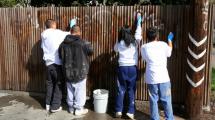Youth who receive special education services under the Individuals with Disabilities Education Act (IDEA 2004) and especially young adults of transition age, should be involved in planning for life after high school as early as possible and no later than age 16. Transition services should stem from the individual youth’s needs and strengths, ensuring that planning takes into account his or her interests, preferences, and desires for the future.
Workforce Development/Employment
Native Americans have a higher poverty and unemployment rate, compared with the national average.1 In 2007, 12 percent of AI/ANs aged 16 and older were unemployed, a rate much higher than other population groups in the U.S.2 More than one in three AI/AN children live in poverty.3
The U.S. Department of Labor administers the Division of Indian and Native American Programs to maximize the federal commitment to support the growth and development of Native American people and communities as determined by representatives of these communities. The funding from the Workforce Investment Act, reauthorized in 2014 as the Workforce and Innovation Opportunity Act, improves the academic, occupational, and literacy skills of Indian, Alaska Native, and Hawaiian adults and youth, making them more competitive in the workforce.4
The Indian and Native American Supplemental Youth Services Program (PDF, 1 page) provides summer and year-round employment and training activities for AI/AN youth between the ages of 14 and 21. Program resources are targeted to at-risk youth who face substantial barriers to education and employment success, including youth who have dropped out of high school and youth who lack basic skills.5
Resources
Division of Indian and Native American Programs
This website has been designed primarily to provide general information and assistance to Workforce Investment Act (WIA) Section 166 Indian and Native American (INA) grantees and others interested in economic self-sufficiency through employment and job training for Native Americans.
Indian and Native American Summer Youth Employment Initiatives and the 2009 Recovery Act (PDF, 66 pages)
This report describes funding granted to Indian and Native American (INA) youth from the 2009 American Recovery and Reinvestment Act and how funds were used to serve INA youth.
The Center for Native American Youth at the Aspen Institute
This website provides an in-depth list of resources around fellowships and internships for youth.
The National Congress of American Indians
The National Congress of American Indians provides several channels to support Native youth, including internships and fellowships, the NCAI Youth Commission, the National Native Youth Cabinet, and NDN Spark.
References
Other Resources on this Topic
Agencies
Announcements
Feature Articles
Programs
Publications
Resources
Youth Topics
Youth Briefs
Research links early leadership with increased self-efficacy and suggests that leadership can help youth to develop decision making and interpersonal skills that support successes in the workforce and adulthood. In addition, young leaders tend to be more involved in their communities, and have lower dropout rates than their peers. Youth leaders also show considerable benefits for their communities, providing valuable insight into the needs and interests of young people
Statistics reflecting the number of youth suffering from mental health, substance abuse, and co-occurring disorders highlight the necessity for schools, families, support staff, and communities to work together to develop targeted, coordinated, and comprehensive transition plans for young people with a history of mental health needs and/or substance abuse.
Nearly 30,000 youth aged out of foster care in Fiscal Year 2009, which represents nine percent of the young people involved in the foster care system that year. This transition can be challenging for youth, especially youth who have grown up in the child welfare system.
Research has demonstrated that as many as one in five children/youth have a diagnosable mental health disorder. Read about how coordination between public service agencies can improve treatment for these youth.
Civic engagement has the potential to empower young adults, increase their self-determination, and give them the skills and self-confidence they need to enter the workforce. Read about one youth’s experience in AmeriCorps National Civilian Community Corps (NCCC).






